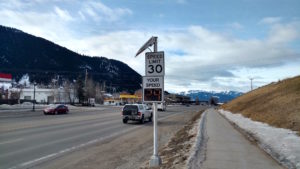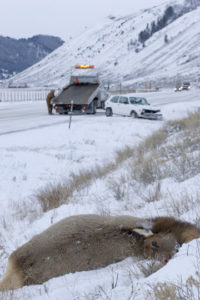By Kyle Kissock |
Do slower speeds reduce the chance of a wildlife-vehicle collision?
While the short answer is yes, the longer answer is likely a bit more complicated.

In winter, ungulates like mule deer cluster on the low-elevation buttes around town. Driving the posted speed can help reduce your chances of a collision with an animal.
An article in a recent Jackson Hole News and Guide highlighted the research of biologist Corinna Riginos, who was contracted by the Wyoming Department of Transportation to study the effects of reduced nighttime speed limits on wildlife-vehicle collision (WVC) rates on high-speed roadways.
Riginos’s results indicated that site-specific, nightly speed limit reductions from 70 mph to 55 mph failed to decrease WVCs.
The reason? Despite lower posted nightly speed limits (and in some cases increased enforcement) drivers decreased their average vehicle speeds only 3-5 mph.
This decrease in speed was likely not enough to compensate for the fact that vehicles traveling through “high-speed” study sites were moving relatively fast to begin with.
As the vast majority of WVCs occur at night, drivers involved in collisions likely still “outran” their headlights, a phenomenon that becomes increasingly hard to avoid (even for attentive drivers) as vehicle speeds exceed 35 mph.
However, it’s important to note that this study focused on a specific type of road; high-speed, two lane highways, and does not mean that slower speed limits are ineffective at preventing WVCs.

Rigino’s recent study showed that on high-speed roadways (70-80 mph) nighttime speed limit reductions had little effect to reduce wildlife-vehicle collisions
As Riginos points out, research indicates that deer-vehicle collisions in zones with permanent speed limits of 65 mph were over 60% more likely to occur than deer-vehicle collisions in zones with permanent speed limits of 55 mph. In these areas, even a 10 mph decrease made a significant difference.
What about nightly speed limits in Teton County?
Although it does get harder to avoid WVCs at night as you “outrun” your headlights, reducing your vehicle speed still means increased reaction time as a driver.
Currently, ungulates in our valley are residing at low elevations and spending time on or near roadways where travel is easier than wading through the deep winter snow pack.
It’s on these town and county roads, where speed limits are relatively low to begin with, that driver behavior can have an out sized impact on avoiding collisions with wildlife.
For example, reducing your speed from 40 mph 30 mph on Broadway (in the 30 mph posted stretch) likely has more of an impact on collision avoidance than if you were to reduce your speed from 80 mph to 70 mph on, say, Interstate-80.
Moose-Wilson Rd, N. Highway 89 in Grand Teton National Park, and south of town near Rafter J are examples of where recent WVCs have occurred, and where abiding by the speed limit at night (it is the law after all) can truly safe a life.
By modeling good driver behavior, those of us who care deeply about wildlife can set examples for the rest of our community to follow!
